In the early days of radio astronomy, many radio sources were detected for which no corresponding visible object was known. By 1960 several hundred such sources were listed in the Third Cambridge Catalog, and astronomers were scanning the skies in search of optical counterparts. Their job was made difficult both by the low resolution of the radio observations (which meant that the observers did not know exactly where to look) and by the faintness of these objects at visible wavelengths.
In 1960, astronomers detected what appeared to be a faint blue star at the location of the radio source 3C 48 (the 48th object on the Cambridge list) and obtained its spectrum. Containing many unknown broad emission lines, the unusual spectrum defied interpretation. 3C 48 remained a unique curiosity until 1962, when another similar-looking, and similarly mysterious, faint blue object with "odd" spectral lines was discovered and identified with the radio source 3C 273. Several of these peculiar objects are shown in Figure 25.16.
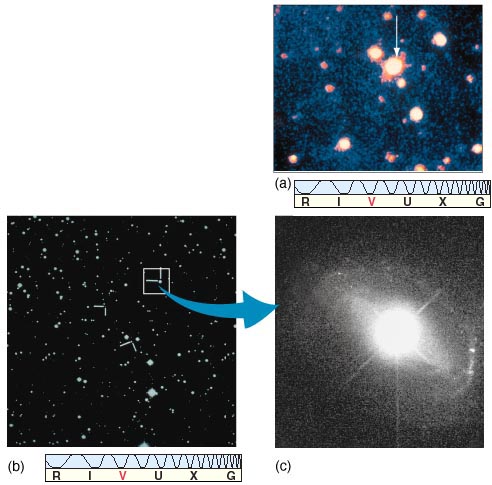
Figure 25.16 (a) Optical photograph of 3C 275, one of the first quasars discovered. Its starlike appearance shows no obvious structure and gives little outward indication of this object's enormous luminosity. However, 3C 275 has a much larger redshift than any of the other stars or galaxies in this image; it is about 2 billion pc away. (b) Optical image of a field of quasars (marked), including QSO 1229+204, one of the most powerful quasars yet discovered, shown enlarged in (c). Its starlike appearance shows only a hint of structure and gives little outward indication of the object's enormous luminosity. Like 3C 275, its distance from Earth is about 2000 Mpc.
The following year saw a breakthrough, when astronomers realized that the strongest unknown lines in 3C 273's spectrum were simply familiar spectral lines of hydrogen redshifted by a very unfamiliar amount—about 16 percent! This large redshift indicated a recessional velocity of about 44,000 km/s (see More Precisely 25-1). Figure 25.17 shows the spectrum of 3C 273. Some prominent emission lines, and the extent of their redshift, are marked. Once the nature of the strange spectral lines was known, astronomers quickly found a similar explanation for the spectrum of 3C 48. Its 37 percent redshift implied that it is receding from Earth at almost one-third the speed of light.
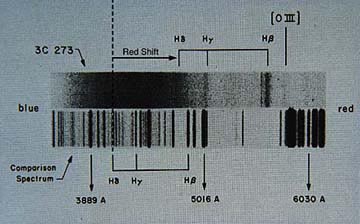
Figure 25.17 Optical spectrum of the distant quasar 3C 273. Notice both the redward shifts and the widths of the three hydrogen spectral lines marked as H , Hy, and H
. The redshift indicates the quasar's enormous distance. The width of the lines implies rapid internal motion within the quasar itself. (Note that in this figure, red is to the right and blue is to the left.)
These huge speeds mean that neither of the two objects can possibly be members of our Galaxy. Applying the Hubble law (with our adopted value of the Hubble constant H0 = 65 km/s/Mpc), we obtain distances of 660 Mpc for 3C 273 and 1340 Mpc for 3C 48. (More Precisely 25-1 discusses in more detail how these distances are determined and what they mean). Clearly not stars (with such enormous redshifts), these objects became known as quasi-stellar radio sources ("quasi-stellar" simply means "starlike"). The term has been shortened to quasars. Because we now know that not all such highly redshifted, starlike objects are strong radio sources, the term quasi-stellar object (or QSO) is more common today. However, the name quasar persists, and we will continue to use it here.
The most striking characteristic of the several hundred quasars now known is that their spectra all show large redshifts, ranging from 0.06 (that is, a 6 percent increase in wavelength) up to the current maximum of about 5. (See More Precisely 25-1 for an explanation of the meaning of redshifts greater than 1.) Thus, all quasars lie at large distances from us—the closest is 240 Mpc away, the farthest nearly 5500 Mpc (Table 25.1). The majority of quasars lie more than 1000 Mpc from Earth. We therefore see most quasars as they existed long ago—they represent the universe as it was in the distant past.
Thus, despite their unimpressive optical appearance—see for example, Figure 25.18, which compares a quasar and a spiral galaxy that happens to lie close to it on the sky—the large distances implied by quasar redshifts mean that these faint "stars" are in fact the brightest known objects in the universe! 3C 273, for example, has a luminosity of about 1040 W. More generally, quasars range in luminosity from around 1038 W—about the same as the brightest radio galaxies—up to nearly 1042 W. A value of 1040 W, comparable to 20 trillion Suns or 1000 Milky Way Galaxies, is fairly typical. Thus quasars outshine the brightest normal and active galaxies by about a factor of 1000.

Figure 25.18 Although quasars are the most luminous objects in the universe, they are often rather unimpressive in appearance. In this optical image, a distant quasar (marked by an arrow) is seen close (on the sky) to a nearby spiral galaxy. The quasar's much greater distance makes it appear much fainter than the galaxy.
Quasars display many of the same general properties as active galaxies. Their radiation is nonthermal, and some show evidence of jets and extended emission features (although few quasars are more than a ball of luminous fuzz in visible-light images). Figure 25.19 is an optical photograph of 3C 273. Notice the jet of luminous matter, reminiscent of the jet in M87, extending nearly 3 kpc from the quasar itself. Often, as shown in Figure 25.20, quasar radio radiation arises from regions lying beyond the bright central core, much like the emission from core—halo and lobe radio galaxies. In other cases the radio emission is confined to the central optical image. Quasars have been observed in the radio, infrared, optical, ultraviolet, and X-ray parts of the electromagnetic spectrum, and some have even been found to emit gamma rays. However, most quasars emit most of their energy in the infrared.
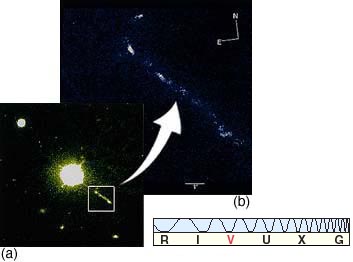
Figure 25.19 (a) The bright quasar 3C 273 displays a luminous jet of matter, but the main body of the quasar is starlike in appearance. (b) The jet extends for about 30 kpc and can be seen better in this high-resolution image.
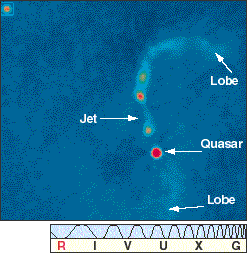
Figure 25.20 Radio image of the quasar 2300-189 showing radio jets feeding faint radio lobes. The bright (red) central object is the quasar, some 400 Mpc away.
In addition to their own strongly redshifted spectra, many quasars also show additional absorption features that are redshifted by substantially less than the lines from the quasar itself. For example, the quasar known as PHL 938 has an emission-line redshift of 1.955, placing it at a distance of some 3900 Mpc, but it also shows three sets of absorption lines, with redshifts of 1.949, 1.945, and 0.613, respectively. The first two sets may well come from high-speed gas within the quasar itself (the differences in recession velocity are only a few hundred kilometers per second), but the third is interpreted as arising from intervening gas that is much closer to us (only about 2000 Mpc away), which explains why it has a smaller redshift than the quasar itself. The most likely possibility is that this gas is part of an otherwise invisible galaxy lying along the line of sight. Quasar spectra, then, afford astronomers a means of probing previously undetected parts of the universe.
Many quasars have been observed to vary irregularly, and by large factors, in brightness over periods of months, weeks, days, or (in some cases) even hours, in many parts of the electromagnetic spectrum. The same reasoning as we used earlier for active galaxies leads to the conclusion that the region generating the energy must be very small—not too much larger than our solar system in some cases. More Precisely 25-2 discusses another curious aspect of quasar variability that may have much to tell us about the details of the energy source.
Quasars have all the properties described earlier for active galaxies—large luminosities, nonthermal emission, jets, lobes, and rapid variability (implying small size)—so it should come as no surprise that the best current explanation of the quasar engine is basically a scaled-up version of the mechanism powering lower-luminosity active galaxies—accretion onto a supermassive black hole.
A 108— or 109—solar-mass black hole can emit enough energy to power even the brightest (1038-W) radio galaxy by swallowing stars and gas at the relatively modest rate of 1 star every 10 years. To power a 1040-W quasar, which is 100 times brighter, the hole simply consumes 100 times more fuel—10 stars per year. The reprocessing mechanisms that convert the quasar's power into the radiation we actually detect—namely, the ejection of matter in jets and lobes and the reemission of radiation by surrounding gas and dust—probably operate in much the same manner as the mechanisms described earlier for Seyferts and for radio galaxies. The most likely explanation for the large luminosities of quasars is simply that there was more fuel available at very early times, perhaps left over from the formation of the galaxies in which the quasars reside. At the distances of most quasars, the galaxies themselves cannot easily be seen. Often, only their intensely bright nuclei are visible from Earth.
In this picture the brightest known quasars devour about 1000 solar masses of material every year. A simple calculation indicates that if they kept up this rate of energy production for the roughly 10-billion-year age of the universe, a total of 1013 stars would have had to be destroyed. Unless the galaxies housing quasars are much larger than any other galaxy we know of, most of the quasar's parent galaxy would be completely consumed, and the universe should contain many 1013—solar mass black holes—"burned-out" quasars. We have no evidence of the existence of any such objects.
One way around this problem is to suppose that a quasar spends only a fairly short period of time in this highly luminous phase—perhaps a few tens of millions of years. There is theoretical evidence to suggest that black holes tend to eat out "cavities" at the centers of their host galaxies, effectively cutting off their fuel supply through their own greed. Alternatively, as with nearby active galaxies, the high luminosities may be the result of interactions between galaxies in the early universe. The fact that quasars have been observed in some distant galaxy clusters argues in favor of this latter view. For a radically different view of quasars, however, see Interlude 25-2.
In 1979, astronomers were surprised to discover what appeared to be a binary quasar—two quasars with exactly the same redshift and very similar spectra, separated by only a few arc seconds on the sky. Remarkable as the discovery of such a binary would have been, the truth about this pair turned out to be even more amazing. Closer study of the quasars' radio emission revealed that they were not in fact two distinct objects. Instead, they were two separate images of the same quasar! Optical views of such a twin quasar are shown in Figure 25.21.

Figure 25.21 (a) This "twin" quasar (designated AC114 and located about 2 billion pc away) is not two separate objects at all. Instead, the two large blobs (at upper left and lower right) are images of the same object, created by a gravitational lens.These two blobs of light have striking symmetry. The lensing galaxy itself is probably not visible in this image—the two objects near the center of the frame are thought to be unrelated galaxies in a foreground cluster. (b) A larger perspective of AC114 in the night sky.
What could produce such a "doubling" of a quasar image? The answer is gravitational lensing—the deflection and focusing of light from a background object by the gravity of some foreground body (Figure 25.22). In Chapter 23 we saw how lensing by brown dwarfs or other compact objects in the halo of the Milky Way may temporarily cause the light from a distant star to be amplified, allowing astronomers to detect otherwise invisible stellar dark matter in our Galaxy. (Sec. 23.6) In the case of quasars the idea is the same, except that the foreground lensing object is an entire galaxy or galaxy cluster, and the deflection of the light is so great (an arc second or so) that several separate images of the quasar may be formed, as illustrated in Figure 25.23. About two dozen such gravitational lenses are presently known. As telescopes probe the universe with greater and greater sensitivity, astronomers are beginning to realize that gravitational lenses are relatively common, if odd, features of the cosmos.

Figure 25.22 When light from a distant object passes close to a galaxy or cluster of galaxies along the line of sight, the image of the background object (here, the quasar) can sometimes be split into two or more separate images (here, A and B). The foreground object is a gravitational lens.

Figure 25.23 (a) The "Einstein Cross," a multiple-imaged quasar. In this Hubble view, spanning only a couple of arc seconds, four separate images of the same quasar have been produced by the galaxy at the center. (b) An artist's conception of what might be occurring here, with Earth at right and the distant quasar at left.
The existence of these multiple images provides astronomers with several useful observational tools. First, the lensing tends to amplify the light of the quasar, making it easier to observe. Second, because the light rays forming the images usually follow paths of different lengths, there is often a time delay, ranging from several days to several years, between them. This delay provides advance notice of explosive events, such as sudden flare-ups in the quasar's brightness—if one image flares up, astronomers know that in time the others will too, so they have a second chance to study the event. The time delay also permits astronomers to determine the distance to the lensing galaxy by carefully timing the measurements. If enough lenses can be found, this method may provide a reliable alternative means of measuring Hubble's constant that is independent of any of the techniques discussed in Chapter 24.
Third, microlensing—lensing by individual stars in the foreground galaxy—can cause large fluctuations in a quasar's brightness. (Sec. 23.6) Microlensing allows astronomers to study the stellar content of the lensing galaxy. Finally, by studying the lensing of background quasars and galaxies by foreground galaxy clusters, astronomers can obtain a better understanding of the distribution of dark matter in those clusters, an issue that has great bearing on the large-scale structure of the cosmos. Figures 25.24(a) and (b) show how the images of faint background galaxies are bent into arcs by the gravity of nearby galaxy clusters.
(Sec. 24.2) The degree of bending allows the total mass of the cluster (including the dark matter) to be measured.
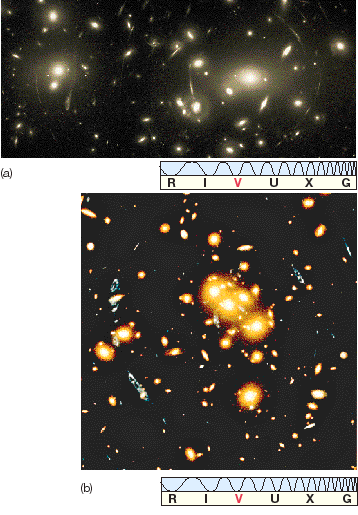
Figure 25.24 (a) This spectacular example of gravitational lensing shows more than a hundred faint arcs from very distant galaxies. The wispy pattern spread across the intervening galaxy cluster (A2218, several billion parsecs distant) resembles a spider's web, but it is really an illusion caused by the gravitational field of the lensing cluster, which deflects the light from background galaxies and distorts their appearance. By measuring the extent of this distortion, astronomers can estimate the mass of the intervening cluster. (b) An approximately true-color image of the galaxy cluster known only by its catalog name, 0024+1654, residing some 1.5 billion pc away. The reddish-yellow blobs are mostly elliptical normal galaxy members of the cluster, concentrated toward the center of the image. The bluish looplike features are thought to be images of a single background galaxy.
The (mostly blue) loop- and arc-shaped features visible in Figure 25.24(b) are thought to be multiple images of a single, distant (unseen) object, lensed by the foreground galaxy cluster (the yellow-reddish blobs in the image). Careful analysis demonstrates the nearly identical shape of each of the blue features, strongly suggesting that they come from a single object, thought to lie nearly twice as far away from us as the intervening cluster. Given the looplike shape and blue color, the distant object may be a normal spiral or ring-shaped galaxy. Astronomers are now trying to delicately "reassemble" an undistorted image of the distant object by tracing its elongated arcs back to a common point.